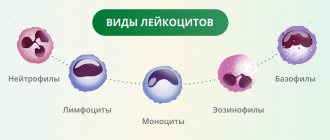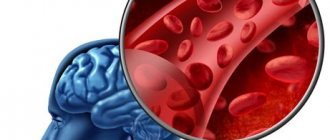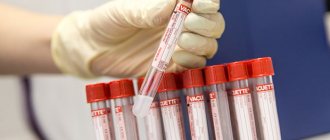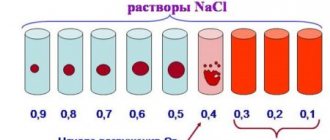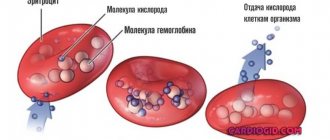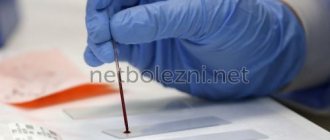What is ROE and its significance for the body
What is RO ESR (ESR)—erythrocyte sedimentation rate. The analysis is one of the main basic blood tests. A referral for examination is issued upon initial consultation with a doctor, before medical procedures or surgical interventions.
Laboratory essence of the method: healthy red blood cells precipitate slowly. Aggregated (glued) red blood cells have a greater mass and settle at a faster rate. Factors that indicate the activation of the immune response to pathology in the body lead to the sticking of red blood cells.
The erythrocyte sedimentation reaction is a nonspecific laboratory indicator that indirectly indicates pathological disorders in the body. Based on ROE, a final diagnosis cannot be made, but the direction of further research can be determined.
The table is normal
The analysis is deciphered taking into account norms that are different for each age. The high variability of norms in women is associated with changes in hormonal levels during different periods of life.
Standards for children:
| Child's age | Floor | ESR norm mm/hour |
| 0-1 month | m/f | 2-3 |
| 1-12 months | m/f | 2-8 |
| 1-5 years | m/f | 4-12 |
| 5-10 years | m/f | 4-12 |
| teenagers | M F | 1-10 2-15 |
For men, the ROE indicator is in the range of 2-15 mm/hour.
In women, ESR has its own characteristics:
- indicators are on average higher than those of men;
- in the morning the indicator increases;
- large variation in the indicator at different periods of life;
- severe pathology is indicated only by long-term and significant deviations of ESR from the norm.
The ROE norm in the blood of women by age is studied in flasks like these. Table below
ROE (the norm for women by age), a table with the value of which shows their change, can range from 2 to 45 mm/hour.
| Age | ESR norm mm/hour |
| Children under 13 years old | 4-12 |
| Teenagers 14-17 years old | 3-18 |
| Young women 18-30 years old | 2-15 |
| Middle-aged women 31-40 years old | 2-20 |
| Middle-aged and perimenopausal women 41-50 years old | 2-30 |
| Women 51-60 years old, menopause, menopause, postmenopause | 2-30 |
| Women over 60 years old | 2-40 |
| pregnant women | 2-45 |
As can be seen from the table, the ROE norm can differ significantly at different age and physiological periods of a woman. The ESR indicator indicates physiological and pathological abnormalities in the body.
Normal for men
Normal Roe indicators in men are somewhat different from those found in women, although the study is carried out in a similar way. In this analysis, the man’s age and the presence of chronic diseases play an important role.
Normal indicators can be seen in the table:
| Age, years | Norm, mm/hour |
| Infants | 43011 |
| Before 18 | 42005 |
| From 18 to 45 | 42949 |
| Up to 60 | To 10 |
| After 60 | Up to 15 |
Ideally, when interpreting analyses, the swarm should be in the range of 1-10 mm/hour. With age, the rate increases slightly, so after 60 years it is up to 15 mm/hour. Unfortunately, during tests, normal ROE values are observed too rarely due to the presence of various chronic diseases and inflammatory processes in the body.
Symptoms of an increased rate
Symptoms indicating increased ROE:
- inflammatory processes accompanied by pain;
- dental pain;
- acute pain in the abdomen;
- heartache;
- pain in the joints and spine.
With a low ESR, the following conditions are observed:
- dizziness;
- nausea;
- weakness;
- yellowing of the skin and whites of the eyes.
A reduced ROE in the body can also be a signal of dangerous pathologies.
Reasons for the increase
The ESR indicator can be increased as a result of physiological processes and pathological changes in the body.
ROE (normal blood levels in women by age), a table with the value of which shows their changes, can reach 45 mm/hour. Thus, during puberty in adolescents, ROE can normally reach up to 19 mm/hour, during pregnancy up to 45 mm/hour, during menopause and menopause up to 30 mm/hour, in women with impaired ovarian function up to 40 mm/hour.
Physiological reasons for an increase in ROE are also allergic reactions, various diets, and fasting.
A pathological increase in ROE occurs in many diseases:
- Inflammatory diseases of various etiologies. Joint pathologies—arthritis, arthrosis, rheumatism, inflammatory-degenerative diseases of the spine.
- Viremia of various origins. Flu, ARVI, herpes diseases.
- Bacterial infections and their complications. Tuberculosis, tonsillitis, bronchitis, pneumonia.
- Endocrine and autoimmune diseases. Diabetes mellitus, systemic lupus erythematosus, thyrotoxicosis.
- Ulcers, abscesses, sepsis.
- Inflammatory diseases of the female genital area. Endometriosis, ovarian cysts, inflammation of the appendages and fallopian tubes.
- Hematopoietic disorders.
- Exacerbations of chronic diseases—pancreatitis, cholecystitis, stomach ulcers.
- Long periods of high ROE may be a sign of the onset of an oncological process.
ROE norm by age
To understand in which direction the results of the study have changed, we focus on the norms of ROE in the blood, depending on gender and age.
Table 1A. Norm ROE depending on age.
| Age | ROE (mm/hour) |
| Infants up to one month old | 0—2 |
| Children under six months | 12—17 |
| Children over 6 months of age | 2—8 |
| Men under 60 years old | 1—8 |
| Men over 60 years old | less than 15 |
| Table 1B. Norm ROE in women by age. | |
| Teenage girls | 15—18 |
| Women under 50 years old | 2—12 |
| Second half of pregnancy | 40—50 |
| Women over 50 years old | less than 20 |
An analysis for ROE can be prescribed if there are female complaints:
- unexplained weight loss;
- anemia;
- pain in the pelvic area;
- headache;
- poor joint mobility.
See also: Causes and removal of bad breath
Increased ROE occurs during menstruation and pregnancy. In the postpartum period, the values of the diagnostic index are normalized.
If the norm in women is increased, further examination is necessary, since the properties of the blood change due to:
- decrease in albumin-globulin ratio;
- changes in blood plasma pH;
- saturation of red blood cells with respiratory protein.
Indications for research
A referral for ESR analysis is most often prescribed by a general practitioner. The analysis is carried out after acute viral and bacterial diseases to exclude the presence of complications.
Subspecialists can prescribe a referral for analysis:
- rheumatologist for joint pain; temperature, increased fatigue;
- surgeon for abscesses, suppuration, abdominal pain;
- nephrologist for problems with the urinary system;
- gynecologist for pain, pathological discharge;
- gastroenterologist for pain in the abdominal cavity, heaviness in the right hypochondrium, yellowing of the skin;
- endocrinologist for specific symptoms indicating metabolic disorders in the body;
- hematologist for a comprehensive examination of the hematopoietic process.
A referral for ESR testing is issued during planned hospitalization and surgical interventions. ESR is part of express tests during emergency operations.
How is the indicator determined?
The ROE indicator is determined using two methods.
Method according to Panchenkov. Blood from the ring finger is examined. The material is transferred to glass and an anticoagulant is added. The resulting laboratory solution is placed in a Panchenkov capillary with 100 divisions.
The erythrocyte sediment deposited within 60 minutes is assessed. The scale readings will be an indicator of the ROE value in mm/hour.
Westergen method . It is used more often; at high ROE levels it is more sensitive. Venous blood is collected for analysis.
The anticoagulant is mixed with the test material in a ratio of 1:4 and placed in a Westergen tube with a graduated scale of 200 mm. The number of red blood cells deposited as sediment is measured in mm/hour.
In the absence of disease, red blood cells precipitate singly, having a negatively charged potential that pushes them away from each other.
Inflammatory and other pathological processes lead to an increase in acute phase proteins in the blood plasma: immunoglobulin, fibrinogen, C-reactive protein. The presence of proteins leads to platelet sticking (aggregation), which causes acceleration of their precipitation.
The erythrocyte sedimentation rate is influenced by the presence of antibodies and lipids in the blood plasma. Plasma can have different oxidation states and ionic charges. The ROE values are affected by the number and shape of red blood cells and blood viscosity.
Important Notes
Material for research
children under 7 years of age: venous blood/capillary blood (for special indications) children over 7 years of age and adults: venous blood Taking capillary blood for research is carried out only for children under 7 years of age (for special indications)! According to GOST R 53079.4-2008, indications for taking capillary blood are possible: in newborns, in patients with very small or hard-to-reach veins, with large-area burns, and severe obesity of the patient.
Preparing for analysis
The ESR indicator is part of the general clinical blood test, but sometimes it is determined separately. Blood is taken from a vein or from a finger, depending on the method used by the laboratory to evaluate the value of the indicator.
To ensure that the test does not show a false positive or false negative result, you need to prepare for the test for several days.
For an accurate measurement:
- take the test before 10 am, strictly on an empty stomach; as an exception, it is permissible to drink a small amount of liquid;
- 2-3 days before the examination, avoid spicy, salty, smoked foods;
- follow a diet, eat boiled or steamed foods;
- Do not drink alcohol or smoke for several hours before the test;
- before the examination, reduce the intensity of physical activity and training;
- Discuss taking medications and performing medical procedures with your doctor.
The results of the analysis may be affected by:
- cyclical changes, hormonal fluctuations in the female body (pregnancy, menopause, menstruation, ovulation);
- stress, psycho-emotional stress;
- other studies and physical procedures performed previously.
When testing blood from a finger, a scarifier, sterile needle or lancet is used. Modern machines for drawing blood from a finger contain a lancet enclosed in a plastic case with a puncture depth regulator. The upper phalanx of the ring finger is wiped with a cotton swab moistened with an antiseptic. After this, blood is drawn.
Only a person qualified as a nurse, paramedic or doctor can take venous blood for analysis. Most often, the median ulnar vein or external superficial vein is used. In some people it is difficult to find a vein. In such cases, blood is drawn from the back of the hand.
A tourniquet is applied to the forearm, and the bend of the elbow is treated with an antiseptic. The needle is inserted at an angle of 45°. After blood is drawn, the arm is bent at the elbow to prevent bruising. The period for performing analysis by any method does not exceed one day.
Conducting research
First, let's figure out what ROE is. Red blood cells, as formed elements of blood, have a certain mass and settle over time, but not always with the same acceleration. The speed depends on the red blood cells themselves and the composition of the plasma. If the immune system is active, the plasma becomes thicker due to additional protein fractions. The latter slow down the process of sedimentation of red blood cells, which affects ROS (erythrocyte sedimentation reaction).
The study is carried out in the morning on an empty stomach. The day before it is necessary to avoid spicy, fried and fatty foods. Before the procedure, you can drink only water, do not drink alcohol, smoke, or be nervous so that the initial data does not change.
The study begins with taking blood from a finger into capillaries with an anticoagulant, which are left in a vertical position in a Panchenkov stand. Within 1 hour, the blood is divided into layers. A column of plasma appears above the layer of settled red blood cells. Its height in mm/hour represents ROE in a blood test.
There is also a more accurate modern automated modification of the Westergren test, in which results are obtained in 30 minutes, but it is rarely used.
Decoding the analysis results
If the test result shows an increased level of ROE, there is no need to immediately panic.
It must be remembered that many factors can influence the increase in the indicator:
- physical and emotional stress;
- taking certain medications—salicylates, hormonal contraceptives;
- recent vaccination;
- helminthic infestations;
- high blood cholesterol, obesity;
- taking vitamins;
- violation of the temperature regime in the room where the analysis was taken.
ROE (normal blood levels in women by age), a table with the value of which shows their changes, may increase for physiological reasons.
Experts say that errors in measurement and physiology can cause a slight increase in ROE to 30-33 mm/hour. The same indicators are observed in anemia and hypoproteinemia, conditions after acute infectious diseases.
An increase in ESR above 60 mm/hour indicates the presence of a serious pathology in the body. High rates occur in sepsis, acute appendicitis, and peritonitis. Joint diseases, especially rheumatoid arthritis, can cause high ESR.
An acceleration of the erythrocyte sedimentation reaction may be the first symptom of malignant tumors, leukemia, and autoimmune diseases. Acute pathologies of the urinary system lead to sharp jumps in ROE.
Causes of pathologically low ESR:
- anemia, thrombocytopenia and other hematopoietic disorders;
- epilepsy;
- pathologies of the liver and kidneys.
Low ROE may have physiological causes: dehydration, vitamin deficiency. Deviations from normal values require re-testing to exclude false results.
Reasons for increased ROE
Increased levels of plasma proteins, cholesterol (), and the ability of blood cells to aggregate are associated with the following pathologies:
- Chronic or acute inflammation of an infectious nature. ESR allows you to find out what stage the disease is at and whether its treatment is effective. With a viral infection of the body, the index has lower parameters compared to bacterial infections.
- Impact of certain medications.
- Hypercholesterolemia.
- Severe poisoning of the body, especially with heavy metals.
- Injury to organs as a result of injury or surgery.
- Disturbances in the functioning of the endocrine glands, increased thyroxine and triiodothyronine (thyroid hormones).
- Damage to the liver, kidneys, intestines, pancreas.
- Heart diseases.
- Rheumatoid arthritis.
An ESR level of up to 70 mm/hour without inflammation may indicate an oncological process. This erythrocyte sedimentation reaction can be observed in various neoplasms, such as lymphosarcoma, myeloma and others.
At what level should you consult a doctor?
Repeated high ROE readings (above 30 mm/hour) require contacting a therapist. The doctor will weigh the possible reasons for the increase and prescribe additional examinations. If a specific pathology is suspected, a referral is issued to a specialist who conducts a detailed examination of the diseased organ.
The main goal of the examination is to find the cause of the anomaly and not to miss the early stage of a dangerous disease. In some situations, it is not possible to find out the reason for the increase in ROE. In this case, they take a wait-and-see position and watch the indicator over time.
ESR in children
In children, fluctuations in ROE in one direction or another are not a sign of infection. You should be concerned at values exceeding 15 mm/hour. Values of 40 or more mm/hour accurately indicate a pathological process.
An increase in ESR in a child can be caused by: sore throat, flu, allergies, colds. Sometimes the reason may be a lack of vitamins in the baby's diet or that he is teething. But most often the ESR rate in children increases for the following physiological reasons:
- taking hormonal medications during lactation;
- anemia;
- vaccination;
- features of the diet of a nursing mother.
It is impossible to understand that the ESR is higher than normal without a special blood test. By elevated body temperature and tachycardia, one can only suspect an approaching infectious process, which is usually accompanied by altered hematological parameters.
After determining the type of pathology, appropriate treatment is prescribed, carried out under medical supervision with regular tests to determine the dynamics of the patient’s condition.
How to get it back to normal
Reducing ESR without finding out the reasons for the increase in the indicator does not make sense. ROE is not a disease, but a diagnostic parameter indicating problems in the body. Self-medication is especially dangerous.
Medications
Some medications have the effect of reducing ROE in the body:
- Aspirin and other medicines containing salicylic acid;
- Calcium chloride;
- mercury-containing preparations;
- antihistamines.
The attending physician makes a diagnosis, as a result of which the ROE level was increased. Treatment of the underlying disease will help normalize the indicator. For infectious pathologies and their complications, antibiotics are usually prescribed: Metronidazole, Tetracycline, Levomycetin, Erythromycin.
For inflammatory lesions of the joints and spine, non-steroidal anti-inflammatory drugs are most effective. The most popular are Diclofenac, Ibuprofen, Indomethacin. New generation drugs that have a gentle effect on the gastrointestinal tract—Meloxicam, Arcoxia.
Indicators of anemia are corrected with the help of medications containing hemoglobin and folic acid: Hemodin, Irovit, Maltofer.
For tuberculosis, drugs active against Koch's bacillus are used: Isoniazid, Rifampicin, Parazinamide. Treatment of autoimmune and endocrine diseases requires specific therapy. Suspicion of a malignant tumor is the basis for immediately sending the patient for consultation to an oncology clinic.
ROE (normal blood levels in women by age), the table with the value of which shows their changes, in some cases can increase significantly. Temporary surges in ESR do not require treatment; after some time the indicator will return to normal on its own.
Traditional methods
To reduce the ESR, you can use folk remedies that will not cause harm to the body and will help strengthen the immune system. Consultation with your attending physician is advisable.
Lemon juice with chopped garlic—the mixture has an antimicrobial effect, improves immunity, and helps lower cholesterol. Mix 100 g of peeled garlic with juice squeezed from four lemons. The mixture should be stored in a cool place. 1 tsp Take the medication once a day before bed.
Honey is a unique natural product that promotes overall health of the body. Accepted according to Art. spoon in the morning or diluted in a glass of warm water.
Beets are rich in B vitamins, potassium, and beneficial microelements. Three well-washed root vegetables are boiled for 2-3 hours. Beetroot decoction is used as a medicine, which is drunk before meals, 2 tbsp. l., course of treatment 2 weeks.
A herbal collection of sea buckthorn berries, chamomile and calendula flowers has antispasmodic, bactericidal, and anti-inflammatory properties. 2 tbsp. l. berries and flowers are brought to a boil and left in a water bath for 20 minutes. Take 100 g before meals 2 times a day.
It is useful to drink herbal teas using coltsfoot grass, linden blossom, and raspberry leaf. Use honey instead of sugar.
Other methods
With minor fluctuations in ROE, a decrease can be achieved by changing your lifestyle in favor of healthy habits. Walking in the fresh air, moderate physical activity, proper nutrition and quitting smoking and alcohol improve laboratory blood counts.
A special diet has been developed to help reduce inflammation in the body and normalize metabolism. Add to the diet: beef, liver, legumes, nuts, beets, dried fruits, green vegetables.
Eating all types of citrus fruits and chocolate helps reduce ESR. Good results are achieved by a course of treatment with B vitamins. An effective drug is Milgamma.
All of the above methods work only with a slight increase in the ROE norm in a blood test in women according to the table. If the erythrocyte sedimentation reaction is more than 30 mm/hour, the attending physician must adjust the indicator.
Decrease in ESR
A drop in ROE levels may be a sign of:
- heart pathologies;
- chronic lack of blood supply;
- dehydration;
- viral hepatitis or cirrhosis of the liver ();
- erythrocytosis - a reactive increase in the number of red blood cells;
- changes in hemoglobin structure ();
- sickle cell anemia, in which red blood cells are shaped like a sickle rather than biconcave discs, which reduces their sedimentation rate;
- high levels of albumin in the blood plasma, increasing its viscosity.
See also: What is Gilbert's syndrome: simply about the complex
A decrease in ESR is also observed with vomiting and diarrhea.
ROE changes differently at different stages of even one pathology:
- With tuberculosis, ROE may remain unchanged, except in advanced cases or until the disease is accompanied by a complication.
- The acute period of an infectious disease is accompanied by an increased ESR only from 2-3 days. At the same time, with a diagnosis of lobar pneumonia, the indicator remains high, even if the crisis has passed.
- At the beginning of acute appendicitis (), the laboratory test values remain unchanged.
- A slight increase in ROE is observed with active rheumatism, but its decrease may indicate acidosis or blood thickening.
- The subsiding infectious process is accompanied by normalization of the total number of leukocytes, ROE decreases later.
Possible complications
If an ESR indicator is detected that is significantly higher than normal, it is necessary:
- identify the cause;
- carry out therapy for the underlying pathology;
- observe ESR values over time until readings appear that correspond to the norm.
Some life-threatening conditions may occur in an atypical form, with no characteristic symptoms. High ROE helps diagnose acute appendicitis, ectopic pregnancy, ruptured ovarian cyst, myocardial infarction, and sepsis. These diseases, if not treated promptly, can be fatal.
For a long time, the ESR rate is above 75 mm/hour, with negative dynamics, requiring a persistent search for an oncological process in the body.
Every woman who cares about her health should know the ROE norm in a blood test according to her age. The table indicates which deviations can be caused by physiological reasons, which indications indicate pathological changes in the body.
Article design: Mila Friedan
ROE in the blood: what is this indicator?
ROE is one of the indicators in a general blood test that helps detect diseases of an inflammatory, infectious and autoimmune nature. Determines the erythrocyte sedimentation rate. The analysis is nonspecific, so deviations from the norm are possible even in healthy people.
During the treatment of certain diseases, it allows you to evaluate the effectiveness of the therapy.
Your doctor may order this test:
- For diagnostics and preventive examinations.
- When identifying inflammatory, infectious and autoimmune diseases.
- Assessment of the quality of treatment provided.
- To identify oncological processes in the body.
The material for analysis is blood from a vein and from a finger. The most accurate result is obtained by the Westergren testing method, when blood is taken from a vein and a more accurate scale is used to evaluate the result. By itself, ROE analysis will not be able to identify a specific disease, but together with other studies it is of great help in making an accurate diagnosis.
Erythrocyte sedimentation rate
